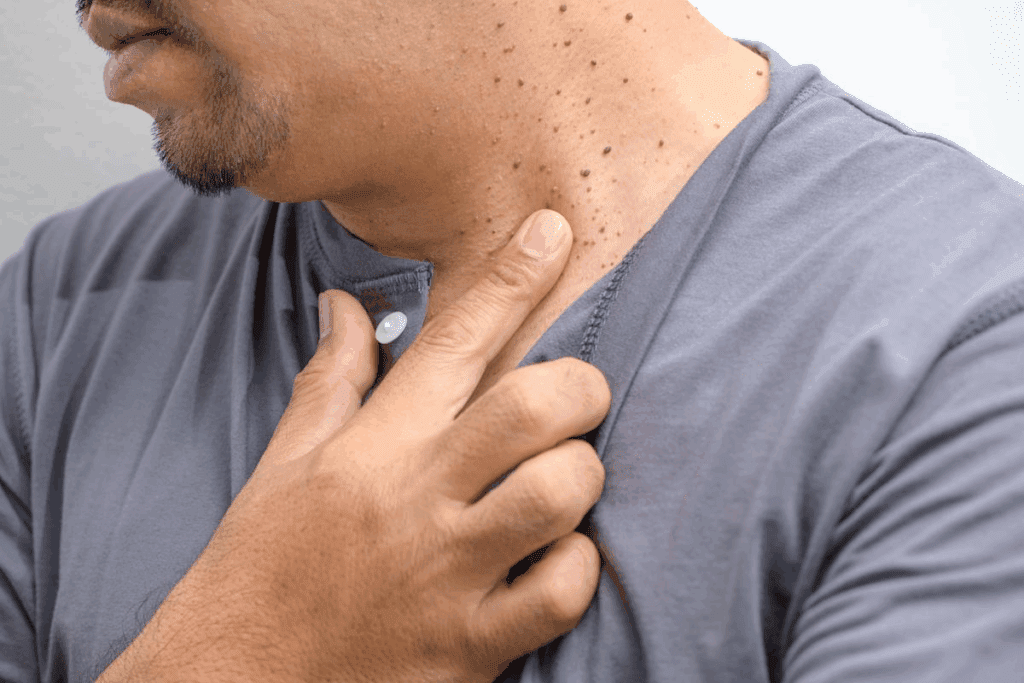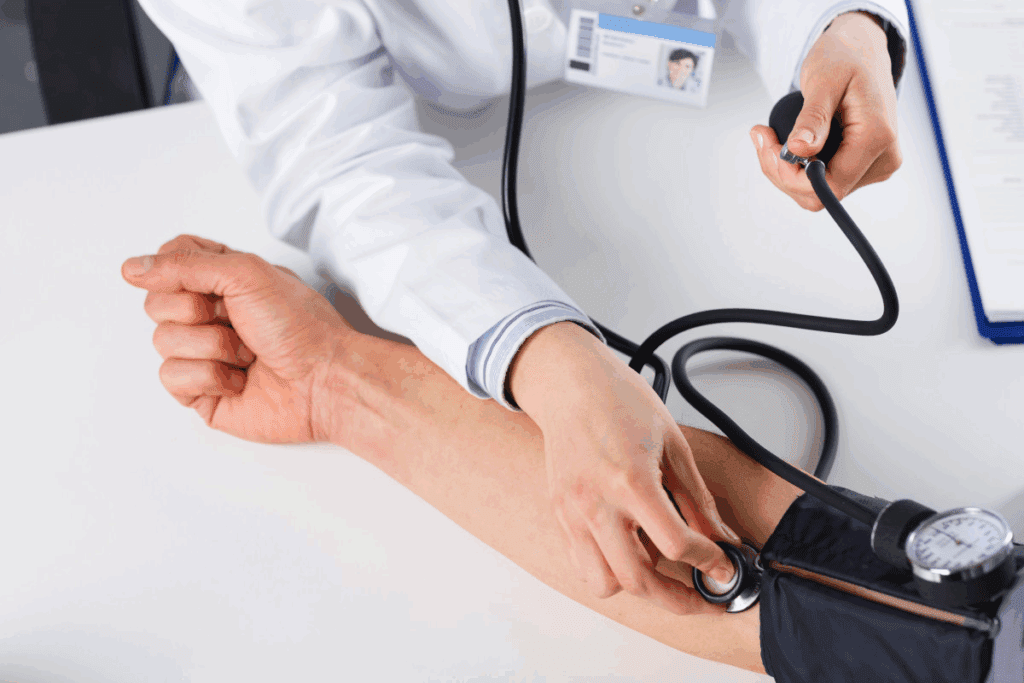Last Updated on November 27, 2025 by Ugurkan Demir

Melanoma on the head and neck is a big health worry. About 30 percent of all melanomas happen in these areas. Finding it early is key because melanoma here often has a poor outlook, even more so on the scalp. How to identify melanoma on head and neck using the ABCDE rule and why early detection is critical in these areas.
The five-year survival rate for those with melanoma that hasn’t spread is 98 percent. But, if it has spread, the survival rate drops a lot. Knowing the warning signs and getting a doctor’s check when you notice changes can greatly improve treatment results.

It’s important to know about melanoma on the head and neck for early detection and treatment. Melanoma is a skin cancer that starts in melanocytes. These cells make melanin, the pigment that colors our skin.
Melanoma begins in melanocytes. These cells are in the skin and other parts of the body, like the eyes and mucous membranes. When these cells turn cancerous, they can cause melanoma. “Melanoma is a serious skin cancer that can be deadly if caught late,” say dermatologists.
Head and neck melanoma is a big worry because it’s common and serious. It usually hits people aged 50 to 80, with more men affected, often on the scalp and ears. Recent stats show melanoma in the head and neck area makes up a big part of all melanoma cases. This shows we need to be more aware and take steps to prevent it.
Melanomas on the head and neck are harder to treat than others. This is because they’re often found late, have a lot of blood vessels, and are tricky to operate on. Also, they’re close to important parts, making treatment harder.
Early detection is key to better survival chances and fewer complications. Knowing the risks and spotting signs early can greatly improve the outcome.

Melanoma can show up in many spots on the head and neck. Knowing where to look is key for catching it early. The most common type, superficial spreading melanoma, starts by growing across the skin before sinking deeper.
Scalp melanoma is a serious issue because it can spread fast. The scalp is a common spot for melanoma, mainly in people who spend a lot of time in the sun.
Look out for any changes in moles or new growths, like the ABCDE criteria (Asymmetry, Border irregularity, Color variation, Diameter, Evolving). Regular self-checks and knowing these signs can lead to early detection.
Facial melanoma can pop up on the cheeks, forehead, and temple. These areas get a lot of sun damage, raising the risk of melanoma.
It’s vital to watch moles on your face for any changes. Facial melanoma can be very aggressive.
Ear melanoma is rare but dangerous because of its location. The ear is sensitive, so any suspicious moles or growths need quick attention.
Moles on the neck and back of the neck are common. But it’s important to tell the difference between harmless moles and melanoma. Changes in size, color, or shape of moles in these areas should be checked by a dermatologist.
| Location | Common Characteristics | Warning Signs |
| Scalp | Often hidden, making self-examination challenging | New or changing moles, bleeding |
| Face (Cheeks, Forehead, Temple) | More visible, but can be overlooked | Asymmetry, border irregularity, color variation |
| Ears | Less common, but potentially aggressive | New growths, changes in existing moles |
| Neck and Back of Neck | Can be hidden or visible | Changes in size, color, or shape of moles |
Several factors can increase the risk of getting head and neck melanoma. These include genetics, environment, and personal habits. Knowing these risks helps people protect their skin and catch problems early.
Age is a big factor in getting head and neck melanoma. Lentigo maligna melanoma often hits people over 60. They should watch their skin closely. Men are more likely than women to get melanoma in these areas. It’s key for men to get regular skin checks.
Studies show melanoma risk goes up with age. This means older adults need to watch their skin health closely.
Sun exposure and UV damage are major risks for melanoma on the head and neck. The scalp, face, and ears get more sun and are at higher risk. Using sunscreen, hats, and staying in the shade can help protect against UV damage.
“UV radiation from the sun or tanning beds is the most preventable risk factor for skin cancer, including melanoma.”
American Academy of Dermatology
It’s important to be careful about sun exposure, even in off-peak hours. Wearing protective clothing and using high SPF sunscreen is a must.
Genetics also play a big role in melanoma risk. People with a family history of melanoma or certain genetic mutations, like CDKN2A, are at higher risk. Those with a family history should talk to a dermatologist about their risk and screening options.
| Risk Factor | Description | Prevention/Monitoring |
| Age | Increased risk over 60 years | Regular skin checks |
| Sun Exposure | UV damage from sun or tanning beds | Use sunscreen, hats, seek shade |
| Genetic Predisposition | Family history or genetic mutations | Consult a dermatologist, genetic testing |
Having had skin cancer before raises the risk of getting it again. People with a history of skin cancer should watch their skin closely, paying special attention to the neck and back of the neck.
Knowing the risks for head and neck melanoma and taking steps to prevent it can help catch it early. Regular self-exams and professional skin checks are key to finding melanoma early.
The ABCDE method helps spot moles that might be cancerous, like those on the temple and forehead. It’s a simple way to remember what to look for in melanoma.
Asymmetry is a key sign of a suspicious mole. Draw a line through it; if the halves don’t match, it might be melanoma. Asymmetry is often the first sign of a mole turning cancerous.
A mole with a jagged or blurry edge is a worry. Benign moles have smooth edges. It’s important to check your moles closely for this sign.
Melanomas often have different colors or uneven color. Benign moles are usually one color, but melanoma can be many. Watching for color changes is key.
Melanomas are often bigger than benign moles. While a pencil eraser is a common size, melanomas can be smaller. Any size change in a mole is a reason to see a doctor.
Using the ABCDE method helps you check your moles for melanoma signs. If you see any of these, see a dermatologist. Early detection is critical for treating melanoma.
Knowing these signs and checking your skin regularly can help protect your health. Remember, the ABCDE method is just a guide. Only a doctor can confirm melanoma.
There are more warning signs to watch for when checking for melanoma on the head and neck. Knowing these signs can help catch melanoma early. This can save lives.
Bleeding or crusting of a mole is a serious sign. If a mole on your head or neck bleeds without reason, or crusts over, see a dermatologist. These signs mean the mole might be cancerous and needs quick attention.
Itching or tenderness around a mole is a warning sign. Itching can mean many things, but with melanoma, it often means the mole is changing. Tenderness also suggests a problem that needs checking.
Melanomas grow in odd ways, like getting bigger fast or changing shape. If a mole that was flat becomes raised, or grows a lot quickly, see a doctor. Watching for these changes is key to catching melanoma early.
Changes in the skin around a mole can also be a sign of melanoma. Look for redness, swelling, or texture changes. These signs mean the mole might be affecting the skin around it, which could be serious.
To better understand the warning signs, let’s summarize the key indicators in the following table:
| Warning Sign | Description |
| Bleeding or Crusting | Mole bleeding without cause or developing a crust |
| Itching or Tenderness | Mole itches or is tender to the touch |
| Unusual Growth Patterns | Rapid enlargement or changes in elevation |
| Changes in Surrounding Skin | Redness, swelling, or texture changes around the mole |
Watching for these signs can help find melanoma early. If you see any, see a doctor right away. Early detection and treatment are key to beating melanoma on the head and neck.
Regular self-exams can help find melanoma on the head and neck early. Being proactive lets you spot problems before they get worse.
To do a good self-exam, you’ll need a few things:
Checking your scalp is tough, but it’s key. Use a comb or hair dryer to see your scalp. For tricky spots, get a partner or spouse to help.
Look closely at your face, focusing on sun spots like the forehead, nose, and ears. Don’t miss the neck and the back of your ears.
| Area to Check | What to Look For |
| Face | New or changing moles, mainly on sun spots |
| Ears | Moles or spots on the outer ear, behind the ear, or in the ear canal |
| Neck | Moles or spots on the front, back, and sides of the neck |
It’s vital to record your findings and watch for changes. Take photos of any moles or spots you worry about. Note their size, color, and shape. Do this every month to track changes.
By following these steps and being careful with self-exams, you can catch melanoma on head early.
It’s important to know the difference between benign moles and malignant melanoma. This knowledge helps in early detection and treatment. We’ll show you how to tell normal moles from atypical ones and when to worry about black moles on the neck.
Benign moles have certain traits that set them apart from cancerous ones. These include:
Atypical moles, also known as dysplastic nevi, have traits that are concerning. They may look like melanoma. Characteristics include:
It’s vital to tell apart common benign growths from melanoma. While benign growths are not cancerous, melanoma is a serious skin cancer. Key differences include:
Black moles on the neck can be benign, but some traits are concerning. If a mole on the back of your neck shows any of these signs, see a dermatologist:
Early detection is key to treating melanoma effectively. We recommend regular self-examinations and professional check-ups to monitor moles and skin changes.
It’s important to know how melanoma moves to lymph nodes in the neck for treatment. Melanoma is a serious skin cancer that can start on the head and neck. Its spread to lymph nodes is key to its growth.
Melanoma can reach lymph nodes through the lymphatic system. When melanoma cells break off, they travel through lymphatic vessels to nearby lymph nodes. The neck’s lymph nodes are most important for head and neck melanomas.
The process involves several steps:
Spotting signs of lymph node involvement is key for early treatment. Look out for:
It’s important to remember that sometimes lymph node involvement may not show obvious symptoms.
Regular self-checks can help catch problems early. Here’s how to check your neck lymph nodes:
Finding melanoma and its spread to lymph nodes early can greatly improve treatment. Regular self-exams and doctor visits are key. If you see any unusual changes or signs of lymph node involvement, see a doctor right away.
Melanoma can spread fast and is the main cause of skin cancer deaths. Knowing how melanoma and lymph nodes in the neck are connected helps people take care of themselves better.
Getting medical help quickly is important for treating melanoma, which can appear on the head and neck. Being careful about skin changes can really help with treatment.
If you see any of these signs, you should get medical help right away:
These signs might mean you have forehead melanoma or another skin problem that needs a doctor’s check.
To get a correct diagnosis, you should see a dermatologist. Here’s how to find the right one:
It’s important that your dermatologist knows how to treat skin cancers, like moles neck issues.
When you visit, the dermatologist will carefully check your skin. They will:
This detailed check is key to finding problems early.
If the dermatologist thinks you might have melanoma, they might take a biopsy. The table below shows the common tests:
| Procedure | Description |
| Visual Examination | A thorough visual inspection of the skin |
| Biopsy | Removing a sample of skin for further analysis |
| Dermoscopy | Using a dermatoscope to examine skin lesions in detail |
Knowing about these tests can help you feel more ready for what’s next.
Identifying melanoma on the head and neck is very important for effective treatment. Melanoma on the neck can spread to lymph nodes, making it dangerous. Early detection is key, with a 98 percent survival rate if caught early.
Prevention is key to reducing melanoma risk. By taking care of our skin, we can lower our risk. Regular self-exams and professional checks help spot moles and melanomas early.
We urge you to watch your skin and seek medical help for any unusual changes. Together, we can improve melanoma detection and treatment, saving lives.
Melanoma can show up in many places on the head and neck. This includes the scalp, face, ears, and neck. The scalp is at high risk because it has lots of melanocytes and gets a lot of sun.
The ABCDE method helps spot moles that might be cancerous. Look for Asymmetry, Border irregularity, Color variation, Diameter larger than 6mm, and Evolving shape or size. If a mole shows any of these signs, see a dermatologist.
Several factors increase your risk of head and neck melanoma. These include getting older, being male, and getting a lot of sun. Genetics and having had skin cancer before also play a role.
To check yourself, use a mirror, good light, and a comb or hair dryer. Look at your scalp, face, ears, and neck for any odd moles or changes. Keep track of any changes over time.
Signs of lymph node involvement include swelling or tenderness in the neck. You might also notice a lump or bump, or feel like your neck is full or tight. If you see these signs, see a dermatologist right away.
If a mole changes, bleeds, itches, or grows in an odd way, get it checked. Also, if you have a new mole that worries you, see a doctor. Look out for moles that change fast or look irregular.
Benign moles are usually symmetrical, have a regular border, and are the same color. Malignant melanoma is often asymmetrical, has an irregular border, and has different colors. If unsure, always check with a dermatologist.
A dermatologist will carefully check your skin during an exam. They’ll use special tools to look at hard-to-see spots. They might take a biopsy if they think it’s melanoma or another skin issue.
Most black moles are harmless, but watch them for changes. If a mole on your neck looks asymmetrical, has an irregular border, or changes size or color, see a dermatologist. They can check if it’s melanoma.
Yes, melanoma on the head and neck can be treated well if caught early. Early detection is key to stopping cancer from spreading and improving treatment results.
Subscribe to our e-newsletter to stay informed about the latest innovations in the world of health and exclusive offers!